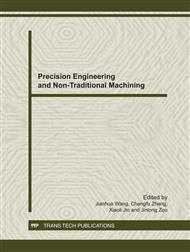p.437
p.442
p.447
p.452
p.456
p.461
p.469
p.474
p.478
Failure Analysis and Design Improvements of MEMS Explosive Interrupter
Abstract:
Due to deformation of the cantilever and lock, the MEMS explosion interrupter used in fuze often cannot move properly. An explosion interrupter with improved strength is proposed. The caudal shape of the cantilever is improved and its structure is changing from the straight hook to the bend hook. The thickness and the patulous angle of the lock is enhanced. Simulation results show that the improved caudal shape of the cantilever is not stuck by the baseplate boss and the improved lock could enter into the locker successfully. The explosion interrupter moves in-position under centrifugal force and be locked.
Info:
Periodical:
Pages:
456-460
Citation:
Online since:
November 2011
Authors:
Price:
Сopyright:
© 2012 Trans Tech Publications Ltd. All Rights Reserved
Share:
Citation:


